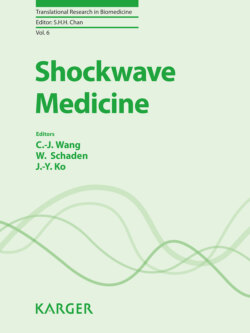Читать книгу Shockwave Medicine - Группа авторов - Страница 22
На сайте Литреса книга снята с продажи.
Osteonecrosis of the Femoral Head and Extracorporeal Shockwave Therapy
ОглавлениеThe etiology of osteonecrosis of the femoral head (ONFH) is multifactorial including alcohol abuse, overweight, trauma, corticosteroid usage, chemotherapy, thalassemia, pregnancy, HIV infection, organ transplantation, ischemia, systemic lupus erythematosus (SLE), and idiopathic [1, 2]. ONFH is usually progressive that leads to collapse or fracture of femoral head, and the disease finally leads to the femoral head collapse, destruction and degenerative changes of hip joint. Several prognostic factors could be observed for the progression of ONFH including the extent and location of the osteonecrotic lesion, lesion size, bone marrow edema in the proximal femur, and genetic factors [2, 3]. Imaging studies, particularly MRI, are the major methods that can accurately evaluate and assess the progression of ONFH. These imaging studies may also assess the risks of femoral head collapse from patients’ perspective and clarify the patient expectation from the perspective of the history of the natural development of the disease. There are several classification systems to identify and staging the ONFH, including Ficat and Arlet classification, Steinberg-the University of Pennsylvania staging system, Association Research Circulation Osseous (ARCO), and the Japanese Orthopaedic Association classification systems (Table 1) [4]. These classification systems provide information of ONFH on the prognosis and assist with treatment decision.
There are many options for treating ONFH including non-weight-bearing (NWB) therapy, pharmacologic treatment, physical support, hyperbaric oxygen (HBO) therapy, core decompression, extracorporeal shockwave therapy (ESWT), and surgery [5]. The purpose of treatment for ONFH is to prevent collapse or delay the stage progression of the femoral head. However, the optimal treatment for ONFH is still not well defined and remains controversial. In general, patients with early ONFH prefer conservative nonsurgical management, but unsatisfactory functional outcomes were noticed in most patients. There is still no completely effective method, even with regard to surgery for ONFH. Better results often rely on early diagnosis and treatment. The type of surgery is dependent on the stage of ONFH images [6, 7]. The operative treatment such as the core decompression with or without bone grafting is the most common surgical procedure for precollapse of ONFH and is regarded as the gold standard for preserving the femoral head. However, the potential risk included infections and immune response, and reports unsatisfactory results [8]. Recently, ESWT was reported effective by researchers in the treatment of ONFH [9–11]. This article describes a new effective and noninvasive method of ESWT for the treatment of ONFH.
